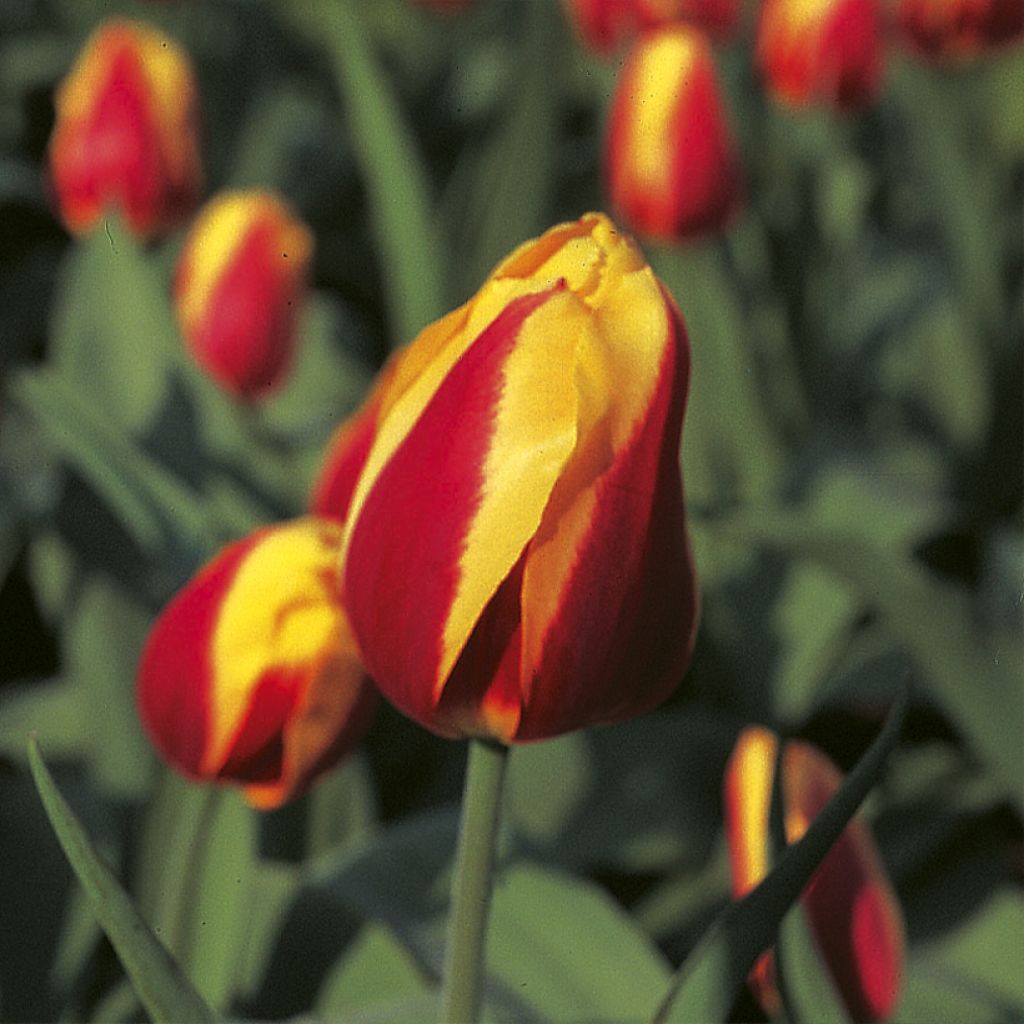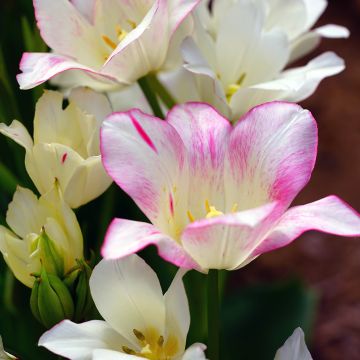

Tulipa Keizerskroon - Early simple Tulip
Tulipa Keizerskroon - Early simple Tulip
Tulipa Keizerskroon
Tulip
Special offer!
Receive a €20 voucher for any order over €90 (excluding delivery costs, credit notes, and plastic-free options)!
1- Add your favorite plants to your cart.
2- Once you have reached €90, confirm your order (you can even choose the delivery date!).
3- As soon as your order is shipped, you will receive an email containing your voucher code, valid for 3 months (90 days).
Your voucher is unique and can only be used once, for any order with a minimum value of €20, excluding delivery costs.
Can be combined with other current offers, non-divisible and non-refundable.
Why not try an alternative variety in stock?
View all →This plant carries a 6 months recovery warranty
More information
We guarantee the quality of our plants for a full growing cycle, and will replace at our expense any plant that fails to recover under normal climatic and planting conditions.

Would this plant suit my garden?
Set up your Plantfit profile →
Description
The Early Single Tulip 'Keizerskroon' attracts all the attention in spring with its sparkling two-tone flowering. The cup-shaped flowers that open in the sun mix canary yellow on the edge of the petals and bright red in the centre. They are beautifully highlighted by the dense foliage, subtly bluish green. Of medium height, it can be grown in the garden, in a pot, or in a container on a terrace. Its good vase life and cheerful and colourful appearance also make it a very good candidate for bouquet arrangements.
The 'Keizerskroon' Tulip belongs to the botanical family of Liliaceae, formerly rich in genera that have been reclassified into other families. Today, there are just over 400 species distributed in about ten genera, the most well-known outside the large group of tulips being lilies and fritillaries. Wild tulips are found from Western Europe to China and Japan, passing through Eastern Europe, Asia Minor, and Central Asia. Their range also includes North Africa and the Indian subcontinent.
Nevertheless, in our gardens, we more frequently find horticultural varieties. The abundance of different tulip forms has led to a classification into 15 divisions. Keizerskroon is thus a representative of the group of Early Single Tulips, which constitutes the 1st division. The tulips in this division produce single cup-shaped flowers less than 8 cm (3in) wide, are relatively short (20 to 40 cm (8 to 16in)), and bloom between late March and early June.
Keizerskroon begins flowering in April and continues into May if the weather is not too hot. The corollas have a rounded, more or less ovoid shape, measuring about 6 cm (2in) in diameter and open in the sun. They are of the single type, consisting of 6 tepals (this term refers to the sepals and petals when they have almost the same morphology). The tepals display a triangular central macula, a bright red, which rises upwards, gradually merging into a similarly vivid yellow. This explosive colour combination is tempered by the foliage, which has a soothing shade, a matte green with a slight blue tint. This variety reaches approximately 35 cm (14in) in height when in bloom, and the long lanceolate leaves rise almost to the base of the corollas. When planted in groups, this tulip forms a dense vegetative mass, enhanced by the exuberance of the two-tone flowers. Growing in full sun or light shade, in most well-drained soils, it can also be cultivated in containers.
This joyful and vibrant tulip will give you stunning bouquets, either alone or combined with other seasonal blooms. Opt for white with plants like the Syringa meyeri 'Flowerfesta White', a dwarf lilac that does not exceed 1.25 m (4ft) in height and will bless your bouquets with a delicious fragrance. In the background of a flower bed, you can also plant a Eucalyptus gunnii, whose bluish foliage will elegantly accompany your tulip flowers in a vase. Peonies are also particularly attractive, with their wide variety of flower shapes and multiple colours, ranging from white to purple, including yellow, pink, salmon, and red. By mixing early and late varieties, you will extend the bouquet season and bring the garden into your home!
Report an error about the product description
Plant habit
Flowering
Foliage
Safety measures
Botanical data
Tulipa
Keizerskroon
Liliaceae
Tulip
Cultivar or hybrid
ingestion
Cette plante est toxique si elle est ingérée volontairement ou involontairement.
Ne la plantez pas là où de jeunes enfants peuvent évoluer, et lavez-vous les mains après l'avoir manipulée.
Pensez à conserver l'étiquette de la plante, à la photographier ou à noter son nom, afin de faciliter le travail des professionnels de santé.
Davantage d'informations sur https://plantes-risque.info
Other Single Tulips
View all →Planting and care
Plant the bulbs in autumn, from September to December, at a depth of 15 cm (6in), spacing them 10 cm (4in) apart. The planting should be done in ordinary soil, slightly acidic, neutral, or slightly alkaline, loose, well-cultivated, and well-drained. Never add undecomposed manure or compost to the planting soil, as this could cause the bulbs to rot. The 'Keizerskrooon' tulip will grow well in moist to dry soil in summer. Plant it in a sunny or partially shaded location. Once flowering is finished, it is preferable to remove the fruits to avoid exhausting the plant.
Planting period
Intended location
Care
This item has not been reviewed yet - be the first to leave a review about it.
Haven't found what you were looking for?
Hardiness is the lowest winter temperature a plant can endure without suffering serious damage or even dying. However, hardiness is affected by location (a sheltered area, such as a patio), protection (winter cover) and soil type (hardiness is improved by well-drained soil).

Photo Sharing Terms & Conditions
In order to encourage gardeners to interact and share their experiences, Promesse de fleurs offers various media enabling content to be uploaded onto its Site - in particular via the ‘Photo sharing’ module.
The User agrees to refrain from:
- Posting any content that is illegal, prejudicial, insulting, racist, inciteful to hatred, revisionist, contrary to public decency, that infringes on privacy or on the privacy rights of third parties, in particular the publicity rights of persons and goods, intellectual property rights, or the right to privacy.
- Submitting content on behalf of a third party;
- Impersonate the identity of a third party and/or publish any personal information about a third party;
In general, the User undertakes to refrain from any unethical behaviour.
All Content (in particular text, comments, files, images, photos, videos, creative works, etc.), which may be subject to property or intellectual property rights, image or other private rights, shall remain the property of the User, subject to the limited rights granted by the terms of the licence granted by Promesse de fleurs as stated below. Users are at liberty to publish or not to publish such Content on the Site, notably via the ‘Photo Sharing’ facility, and accept that this Content shall be made public and freely accessible, notably on the Internet.
Users further acknowledge, undertake to have ,and guarantee that they hold all necessary rights and permissions to publish such material on the Site, in particular with regard to the legislation in force pertaining to any privacy, property, intellectual property, image, or contractual rights, or rights of any other nature. By publishing such Content on the Site, Users acknowledge accepting full liability as publishers of the Content within the meaning of the law, and grant Promesse de fleurs, free of charge, an inclusive, worldwide licence for the said Content for the entire duration of its publication, including all reproduction, representation, up/downloading, displaying, performing, transmission, and storage rights.
Users also grant permission for their name to be linked to the Content and accept that this link may not always be made available.
By engaging in posting material, Users consent to their Content becoming automatically accessible on the Internet, in particular on other sites and/or blogs and/or web pages of the Promesse de fleurs site, including in particular social pages and the Promesse de fleurs catalogue.
Users may secure the removal of entrusted content free of charge by issuing a simple request via our contact form.
The flowering period indicated on our website applies to countries and regions located in USDA zone 8 (France, the United Kingdom, Ireland, the Netherlands, etc.)
It will vary according to where you live:
- In zones 9 to 10 (Italy, Spain, Greece, etc.), flowering will occur about 2 to 4 weeks earlier.
- In zones 6 to 7 (Germany, Poland, Slovenia, and lower mountainous regions), flowering will be delayed by 2 to 3 weeks.
- In zone 5 (Central Europe, Scandinavia), blooming will be delayed by 3 to 5 weeks.
In temperate climates, pruning of spring-flowering shrubs (forsythia, spireas, etc.) should be done just after flowering.
Pruning of summer-flowering shrubs (Indian Lilac, Perovskia, etc.) can be done in winter or spring.
In cold regions as well as with frost-sensitive plants, avoid pruning too early when severe frosts may still occur.
The planting period indicated on our website applies to countries and regions located in USDA zone 8 (France, United Kingdom, Ireland, Netherlands).
It will vary according to where you live:
- In Mediterranean zones (Marseille, Madrid, Milan, etc.), autumn and winter are the best planting periods.
- In continental zones (Strasbourg, Munich, Vienna, etc.), delay planting by 2 to 3 weeks in spring and bring it forward by 2 to 4 weeks in autumn.
- In mountainous regions (the Alps, Pyrenees, Carpathians, etc.), it is best to plant in late spring (May-June) or late summer (August-September).
The harvesting period indicated on our website applies to countries and regions in USDA zone 8 (France, England, Ireland, the Netherlands).
In colder areas (Scandinavia, Poland, Austria...) fruit and vegetable harvests are likely to be delayed by 3-4 weeks.
In warmer areas (Italy, Spain, Greece, etc.), harvesting will probably take place earlier, depending on weather conditions.
The sowing periods indicated on our website apply to countries and regions within USDA Zone 8 (France, UK, Ireland, Netherlands).
In colder areas (Scandinavia, Poland, Austria...), delay any outdoor sowing by 3-4 weeks, or sow under glass.
In warmer climes (Italy, Spain, Greece, etc.), bring outdoor sowing forward by a few weeks.


































